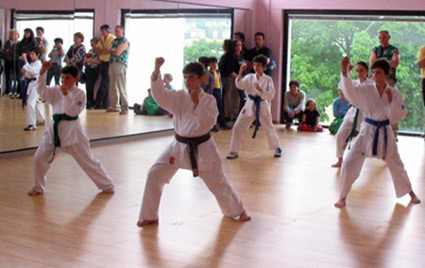 |
 |
|
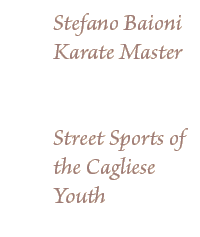

|
There are a lot of “karate kids” in Cagli.
According to head instructor of Karate Cagli, Stefano Baioni, it
is one of most popular sports for ragazzi Italiani, Italian children
under 14. In Cagli, there are no school-sponsored sports, so the
children, particularly girls, seek activity outside of schools,
often choosing karate.
“It’s the first fighting sport that became popular
in Italy. It has become part of the Italian tradition,” said
Baioni.
One student, Simone Ubaldelli, started training early with Baioni
in Cagli and went on to become first in Europe and ranked third
internationally. He now lives in California.
Some of the current students of Karate Cagli are no more than 5
years old, and a majority are girls.
Today, many of his students begin training long before the age
of 14.
“If you want someone to achieve a certain level, you need
to start early,” Baioni said.
Deborah Bazotti,12, one of three of the school’s brown belts,
has been taking karate for seven years. She practices three times
a week for an hour each session.
Deborah said that “era la mia itnas,” it was her choice,
to take karate, not her parents’ or her friends’. She
plans on continuing her training and yearns for her black belt,
which one cannot compete for until the age of 16.
Eleanora Bazotti, 5, earned her yellow belt in the spring of 2004
at a school exhibition. One of Karate Cagli’s youngest students,
she started taking classes a year ago in order to follow in the
footsteps of her older sister, Deborah.
Besides the exhibitions, the karate students travel to other towns
to compete. They often fight others from towns as far as two or
three hours away, said one parent.
Representing Karate Cagli at competitions, Deborah is one of only
three brown belts because, according to Baioni, at 14, many abandon
karate.
|
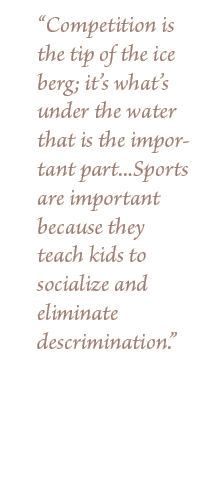 |
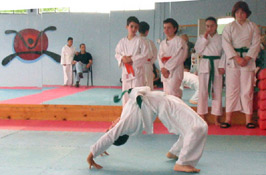 |
“Some kids get tired of karate,” said Antonella Bagiacchi,
a parent of a karate student, adding that Cagliese children’s
favorite sport is usually calcio, soccer. Still others trade karate
for pallacanestro (basketball), pallaudo (volleyball) and nuoto
(swimming) by the age of 14.
“My older son did [karate] for a couple days. … He
was 16 years old, and all the other kids were younger. He didn’t
want to be with a bunch of younger kids,” said Bagiacchi.
Her younger son, 11, has been taking karate for three years and
earned his green belt in the spring of 2004. He has an hour of karate
class twice a week in a class of about 12 students. He and his friend,
11-year-old Riccardo Virgili, began to take karate at the same time.
Both however like soccer and are considering abandoning karate
for the sport.
“I like the fighting part, but the practices get boring,”
Riccardo said.
Although there are no school-sponsored sports, there are other
sporting options in town. A sports club across town offers a wide
range of sports including soccer, basketball, volleyball and swimming.
This option however is only available for boys.
“Young girls can’t go play other sports,” Bagiacchi
said, explaining the importance of karate in Cagli. Though there
are dance schools and various aerobic classes, sports teams for
the girls of Cagli are scarce.
Switching to these other sports, the boys can also find more competition,
an aspect that Baioni says is least important to the young Cagliesi
physical activity.
“Competition is only the tip of the iceberg; it’s what’s
under the water that is the important part,” he said. “Sports
are important because they teach kids to socialize and eliminate
discrimination.”
Karate has moved away from the concept of strength, said Baioni,
who has a black belt. Modern karate deals more with agility and
technical skills.
“Everyone can do karate now, kids, the third generation,
the handicapped. … Karate is something they can handle,”
Baioni said. “It used to be the same karate activities for
all age groups … kids, adults all had the same activities.
Now activities are differentiated for the different age groups.”
|
Professor P.L. Aschieri developed sound karate, “che unisce
la musica al karate,” the performance of karate exercises
to the rhythm of music. In addition to traditional karate, the Karate
Cagli School added it to its curriculum in 1997.
“It just needed to be done. Everything has to do with music
today. From the funeral to the party, there’s music. Music
accompanies all events in life; now this includes karate,”
Baioni said.
According to instructors, the students at Karate Cagli do not just
spar with each other, but learn to collaborate, help and interact
with each other in order to complete the exercises. It is also an
outlet for children to express themselves.
Once a month all year, Cagliesi in white outfits and cinturas (belts)
of varying colors perform tumbles, kicks and jabs on a red-and-blue
puzzle-piece floor and bow in respect before each bout begins.
The competitions are a place where famiglia and amici, family and
friends, come together. Calgiesi mothers and fathers snap photos
and beam proudly. Siblings cheer loudly for each other and applaud
for their fellow vicini, neighbors. Many of the karate students
themselves know each other either as a neighbor or a classmate so
they cheer wildly for each other whenever a new student takes the
floor.
“I like the competition,” Deborah said, and several
other students agreed that it was their favorite part.
In the competitions, the students are scored on three different
types of tasks: de-structured, semi-structured and structured. In
the de-structured task, the students must complete an obstacle course.
In the semi-structured task, the karate student performs punches
and kicks a punching bag. Lastly, the structured task is free form
or sound karate. Then the bouts begin.
Taking karate also helps children excel in other sports, according
to instructors.
“It’s a multilateral activity because it operates on
a wide basis regarding motor skills,” Baioni said.
It costs only 25 euro ($30) a month for a child to take karate
in Cagli. Camps are offered when the school closes down for the
summer months. |
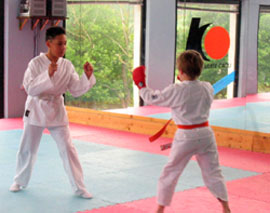 |
Web Layout By: Chas Davis |
Photography By: Jill Strait |
Video By: Danielle Lizardos |
|









